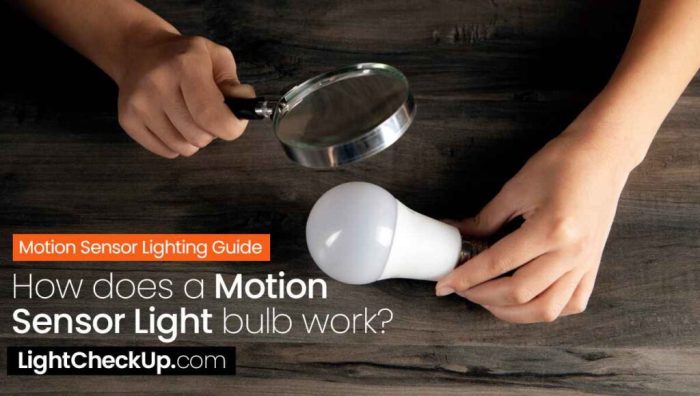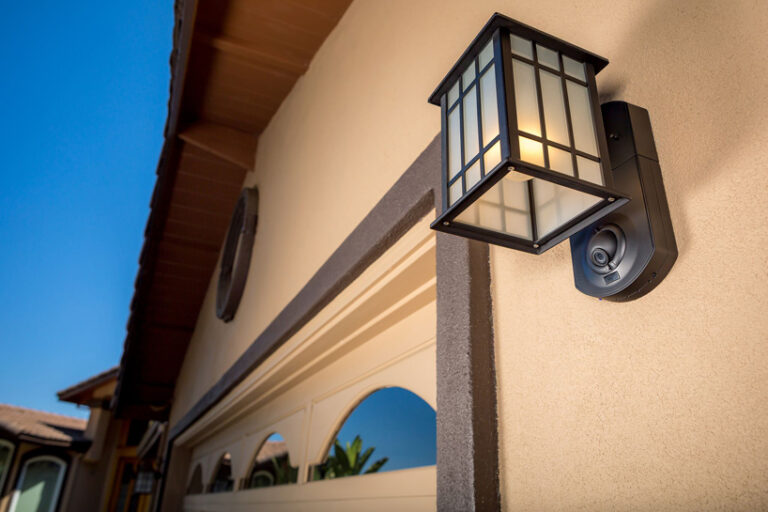Blink Motion Sensor Light A Comprehensive Guide
Blink motion sensor light illuminates the way to enhanced security and convenience. This guide dives deep into the functionalities, installation, and maintenance of these versatile lights, from understanding their components to troubleshooting common issues. We’ll explore various types, installation methods, and performance comparisons to help you choose the best option for your needs.
From basic operation to advanced customization options, this comprehensive guide unpacks the ins and outs of blink motion sensor lights. Whether you’re looking to improve security, enhance ambiance, or simply automate your lighting, this guide provides the essential information to make informed decisions.
Product Overview
A blink motion sensor light is an automated lighting solution that automatically turns on when motion is detected in its vicinity and turns off after a predetermined period of inactivity. This technology enhances safety and energy efficiency by providing illumination only when needed.
This system’s core function is to optimize lighting usage, minimizing energy consumption by preventing lights from remaining on unnecessarily. The detection and response mechanism, along with the various types and installation methods, contribute to the versatility and practicality of this technology.
Fundamental Function

Blink motion sensor lights are designed to respond to movement within a defined area. They are triggered by changes in ambient infrared (IR) radiation, which is a form of electromagnetic radiation. The sensor detects the change in heat signature from a moving object, initiating the lighting system. A timer is typically set to automatically switch the light off after a specified period of inactivity. This timed deactivation avoids wasted energy.
Components, Blink motion sensor light
The typical components of a blink motion sensor light include a motion sensor, a light source (often an LED bulb), a control unit, and a power source. The motion sensor detects movement, the control unit processes this information and activates the light, the light source provides illumination, and the power source provides the necessary energy. The control unit may also contain a timer for automatic shut-off.
Types of Blink Motion Sensor Lights
Various types of blink motion sensor lights are available, catering to different needs and environments. These include indoor and outdoor models.
- Indoor Blink Motion Sensor Lights are designed for use in residential or commercial indoor spaces. These lights are typically smaller and more discreet, with a focus on blending seamlessly into the interior design.
- Outdoor Blink Motion Sensor Lights are designed for exterior use, often featuring a more robust build to withstand harsh weather conditions. These are equipped with weather-resistant materials to ensure longevity in outdoor environments, and are commonly used for security purposes.
Installation Process
The installation process for a Blinkk motion sensor light typically involves mounting the light fixture, connecting the wiring, and configuring the sensor’s settings. The precise steps may vary depending on the specific model. Detailed instructions should be provided with the product.
- Mounting: Securely mount the light fixture to the desired location. This typically involves using screws or adhesive mounts.
- Wiring: Connect the electrical wiring according to the provided instructions. This often involves connecting the power supply, ground, and the light fixture’s connections to the sensor.
- Sensor Configuration: Adjust the sensor’s sensitivity, detection range, and the automatic shutoff timer as per the user’s preferences.
Features and Benefits
Blink motion sensor lights offer a range of features and benefits, including energy efficiency, enhanced security, and convenience.
- Energy Efficiency: Automatic activation and deactivation of lights directly reduce energy consumption, leading to cost savings on utility bills.
- Enhanced Security: Motion detection alerts residents and creates a deterrent effect, enhancing security, especially in areas where lights are usually left on.
- Convenience: Automatic activation and deactivation eliminate the need for manual operation, increasing user convenience, especially when the space is accessed infrequently.
- Safety: The provision of light in areas that may be dark at night improves safety for those using the area.
Installation and Setup
The installation of your Blink motion sensor light is straightforward, requiring minimal technical expertise. Proper installation ensures optimal performance and longevity of the device. This section details the steps for a successful installation, covering various scenarios and potential challenges.
A well-installed motion sensor light is essential for providing reliable security and convenience. Following the instructions precisely will guarantee a smooth and efficient installation process, leading to a functioning light that meets your needs.
Installation Steps
This section articulates the critical steps for installing your Blink motion sensor light, ensuring a safe and effective installation process.
The installation process involves several key steps. First, you should carefully examine the installation location to ensure it is suitable for the chosen installation method. Then, gather the necessary tools and materials before commencing the installation. Finally, proceed with the installation process, ensuring each step is executed correctly.
Connecting to a Power Source
This section guides you through the process of connecting your Blink motion sensor light to a power source, ensuring proper functionality and safety.
Connect the sensor light to the power source using the provided power cord. Ensure the power source is compatible with the sensor light’s specifications. If the installation method involves direct wiring, follow the instructions provided for the correct wiring connections. If the installation is plug-in, plug the power cord directly into a suitable electrical outlet. Double-check that the power cord is securely connected to both the sensor light and the outlet to prevent potential hazards.
Common Installation Challenges and Solutions
This section addresses common issues encountered during installation, offering practical solutions to resolve them efficiently.
A common challenge is ensuring proper alignment of the sensor for optimal detection range. Adjusting the sensor’s position to face the desired area will optimize coverage. Another challenge is verifying the correct wiring connections when using direct wiring. Consult the user manual for detailed wiring diagrams. If the sensor light does not power on after installation, verify the power source and ensure the connection is secure.
Required Tools and Materials

This section details the necessary tools and materials for a successful Blink motion sensor light installation.
The required tools and materials depend on the installation method. For direct wiring, you will need screwdrivers and wire strippers. For plug-in installations, a power cord is sufficient.
Comparison of Installation Methods
This table compares different installation methods, considering various scenarios.
| Installation Method | Scenario | Tools Required | Procedure |
|---|---|---|---|
| Direct Wiring | Outdoor, Permanent Installation | Screwdrivers, Wire Strippers | Connect wires, secure fixture. Ensure proper grounding and compliance with local electrical codes. |
| Plug-in | Indoor, Temporary Installation, or areas with limited access to wiring | Power cord | Connect to a suitable outlet. Ensure the outlet is grounded and capable of handling the load. |
Functionality and Usage: Blink Motion Sensor Light
Blink motion sensor lights are designed for enhanced convenience and security in various environments. Their simple yet effective functionality makes them a popular choice for homeowners and businesses alike. These lights automatically illuminate when motion is detected, providing a practical and energy-efficient solution for areas needing temporary illumination.
Activation Mechanism
The sensor in a Blink motion sensor light utilizes a sophisticated infrared (IR) detection system. When movement is detected within its range, the sensor triggers a signal to the light, causing it to turn on. This system is highly responsive, activating the light quickly in response to detected motion. The IR technology is also effective in distinguishing between human motion and other environmental factors, minimizing false activations.
Sensor Range and Detection Capabilities
The sensor’s range and detection capabilities are crucial factors in determining its effectiveness. Blink motion sensor lights typically have a range of approximately 10-15 meters, though this can vary depending on the specific model and environmental factors. They are designed to detect movement in various directions, providing coverage for the intended area. Obstacles like walls or furniture can potentially affect the sensor’s range and detection capabilities. Furthermore, factors like lighting conditions and the presence of other infrared sources can also impact the sensor’s performance.
Ideal Usage Scenarios
Blink motion sensor lights are ideal for a range of applications. They are particularly suitable for exterior areas like porches, patios, and walkways, providing security and convenience when entering or exiting a property at night. Inside, they are useful in hallways, stairwells, or closets to illuminate areas as needed. They can also be used in commercial settings such as retail stores, warehouses, or garages. These lights are versatile and adapt to various usage scenarios.
Customization Settings
Blink motion sensor lights offer several customization options to tailor their performance to specific needs. Users can adjust the sensitivity of the motion sensor to fine-tune its responsiveness. A higher sensitivity setting will trigger the light more easily, while a lower sensitivity setting will require more significant movement to activate it. The duration of the light’s activation can also be adjusted, allowing users to choose the amount of time the light remains on after motion is detected. This feature helps save energy by ensuring the light turns off after a reasonable period of inactivity.
Brand Performance Comparison
While Blink motion sensor lights are generally reliable, comparing their performance to other brands is important. Some brands may offer slightly different features, such as varied sensor ranges or adjustable lighting levels. Ultimately, the best choice will depend on individual needs and preferences, taking into account the particular features offered by each brand. Comparing user reviews and technical specifications across various brands can provide insight into their relative performance and suitability for different applications.
Maintenance and Troubleshooting

Source: lightcheckup.com
Maintaining your Blink motion sensor light ensures optimal performance and a longer lifespan. Proper care and troubleshooting can resolve minor issues quickly and efficiently. Regular checks and preventive measures are key to avoiding more significant problems down the road.
Troubleshooting is often a straightforward process, requiring only a few simple steps to resolve common issues. This section provides clear guidance on identifying and resolving common problems, as well as proactive maintenance steps to extend the life of your Blink motion sensor light.
Common Issues and Troubleshooting
This section details common problems with Blink motion sensor lights and provides effective troubleshooting steps.
| Problem | Possible Cause | Solution |
|---|---|---|
| The light doesn’t turn on | A faulty sensor, a power outage, a loose connection, or a depleted battery | First, check the power source. Ensure the outlet is functional and the sensor is securely plugged in. Verify the battery is correctly installed and not depleted. If the problem persists, inspect the sensor for damage. A loose connection or a damaged sensor may require replacement. |
| The sensor doesn’t detect motion. | Obstruction, low battery, sensor malfunction, or interference from electronic devices | Begin by clearing any obstructions that may be blocking the sensor’s view. A low battery may require replacement. If the issue persists, the sensor may require replacement. Ensure that no electronic devices are interfering with the sensor’s function. |
| Flickering light | Loose connections, faulty wiring, or a damaged sensor | First, carefully inspect all connections for any looseness or damage. A damaged sensor may need replacement. If the issue persists, consult Blink support for further assistance. |
| Noisy sensorA faulty | Your sensor mechanism or loose components | Check for any loose components within the sensor housing. If the issue persists, a faulty sensor mechanism may require replacement. Consult Blink support for further guidance. |
Maintenance Requirements
Regular maintenance is crucial for maintaining optimal performance and longevity. Regular inspection and minor adjustments can prevent more significant problems.
- Regular Inspection: Visually inspect the sensor for any damage or debris. Check for loose connections or damaged components.
- Cleaning: Gently wipe the sensor housing with a soft, dry cloth to remove dust or debris. Avoid using harsh chemicals or solvents.
- Battery Replacement: Replace batteries as needed, typically when the light’s performance begins to degrade. Consult the Blink user manual for specific battery replacement instructions.
Tips for Extending Lifespan
Implementing these tips can extend the life of your Blink motion sensor light.
- Proper Installation: Ensure the sensor is installed in a suitable location, avoiding direct sunlight or extreme temperatures.
- Avoid Obstructions: Maintain a clear line of sight for the sensor to ensure accurate motion detection.
- Regular Maintenance: Performing regular inspections and cleaning can help prevent premature wear and tear.
Alternatives and Comparisons
Blink motion sensor lights offer a compelling blend of convenience, energy efficiency, and smart home integration. However, understanding how they compare to other lighting options is crucial for making an informed purchase decision. This section delves into the key differences and similarities between blink lights and their counterparts, providing a comprehensive overview of the available choices.
Comparison with Smart Lights
Smart lights, like those from Philips Hue or LIFX, offer a high degree of customization and control. They often integrate seamlessly with smart home platforms, enabling users to adjust brightness, color temperature, and schedules remotely. However, smart lights typically lack the dedicated motion-sensing functionality of the Blink system. This means that smart lights would need a separate motion sensor, adding to the complexity and cost.
Comparison with Traditional Motion Sensor Lights
Traditional motion sensor lights are generally less expensive and simpler in design. Their functionality is limited to basic motion detection, lacking the smart features and connectivity offered by Blink lights. Traditional motion sensor lights often struggle with false triggers and may not offer the same level of energy efficiency as their modern counterparts.
Differentiation from Competitors
Blink lights stand out through their combination of reliable motion detection, streamlined Wi-Fi connectivity, and intuitive mobile app control. This comprehensive suite of features differentiates them from both traditional and smart light alternatives, allowing users to seamlessly integrate motion-activated lighting into their homes without the need for complex setup procedures. Blink’s focus on dependable performance and straightforward integration makes it a strong contender in the smart lighting market.
Use Cases
Blink motion sensor lights are particularly well-suited for areas like hallways, stairwells, and entryways. The immediate activation upon motion detection ensures safety and convenience in these frequently traversed spaces. In contrast, smart lights are suitable for areas where precise color control or dynamic lighting schemes are desired, like living rooms or bedrooms. Traditional motion sensor lights can be cost-effective solutions for basic security lighting in garages or outdoor areas.
Feature and Pricing Comparison
| Feature | Blink Motion Sensor Light | Smart Light | Traditional Motion Sensor Light |
|---|---|---|---|
| Connectivity | Wi-Fi | Wi-Fi/Bluetooth | None |
| Cost | Mid-range | Higher | Lower |
| Motion Detection Accuracy | High | A variable often requires external sensors | Variable, prone to false triggers |
| Customization Options | Limited to brightness, schedules, and motion settings | Extensive, including color temperature, scenes, and advanced control | Minimal |
| Energy Efficiency | Good | Good, depending on bulb type | Variable |
Visual Representation
The Blink motion sensor light offers a practical and visually appealing solution for ambient lighting. Understanding its various aspects, from installation to functionality, enhances its appreciation and use. This section provides a detailed visual representation of the device, highlighting its components, installation, and performance.
Living Room Scene
A modern living room benefits from the subtle yet effective illumination provided by the Blink motion sensor light. Mounted strategically above a sofa, the light ensures the room is well-lit when movement is detected. Ambient lighting from nearby lamps complements the motion-activated light, creating a welcoming and safe environment. The light is unobtrusive, blending seamlessly with the décor.
Detection Range Diagram
The motion sensor’s detection range is crucial for effective operation. A diagram illustrates the coverage area. This circular range, typically 10-12 feet, is indicated with a dotted line. The sensor detects movement within this radius, triggering the light’s activation. A clear visualization of the coverage area aids in placement for optimal performance.
Internal Components
The Blink motion sensor light is comprised of several key components. A compact circuit board houses the sensor, microcontroller, and light-emitting diodes (LEDs). A casing protects these internal elements, ensuring longevity and durability. The housing also provides a mount for secure installation. The sensor, concealed within the casing, is responsible for detecting movement. The LEDs, integrated into the system, emit light when motion is detected. The components are designed for efficient operation and optimal performance.
Well-Maintained Blink Motion Sensor Light
Imagine a Blink motion sensor light, mounted neatly on a wall. The casing appears clean and free from any visible damage. The light itself is emitting a soft, white glow, indicating proper functionality. This visual representation demonstrates a well-maintained device. The clean and undisturbed appearance signifies proper installation and upkeep.
Final Wrap-Up

Source: homelyville.com
In conclusion, blink motion sensor lights offer a practical and efficient solution for various lighting needs. This guide has thoroughly examined the features, installation, usage, and maintenance aspects, providing a detailed understanding of their capabilities. By comparing different models and installation methods, you’re equipped to make the best choice for your specific application. From enhancing home security to automating exterior lighting, these lights stand out as a worthwhile investment.





